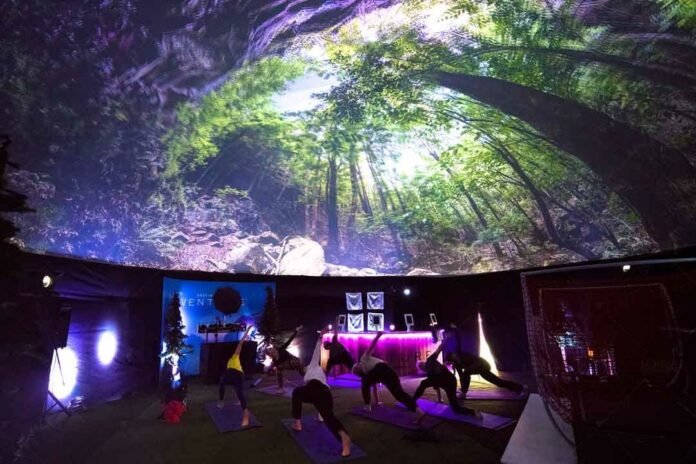In recent years, the world of mapping has been revolutionized with the emergence of 360-degree mapping technology. This technology allows users to explore locations from all angles, giving a new level of immersion and understanding of a place. In this blog post, we’ll take a closer look at the power of 360 mapping and how it is changing the way we explore the world.
What is 360 Mapping?
360 mapping, also known as spherical mapping or panoramic mapping, is a technology that allows the creation of immersive, 360-degree views of a location. This technology combines a series of photographs or videos taken from different angles to create a seamless, interactive view of the location. Users can explore the location by panning and zooming in and out, giving them a more detailed and nuanced understanding of the space.
360 Mapped Yoga Space at Capital One Venture Dome by Lumen and Forge
The Power of 360 Mapping
360 mapping has many practical applications in a variety of fields, from real estate to tourism to education. Here are just a few of the ways that this technology is changing the way we explore the world.
Virtual Tours
One of the most popular applications of 360 mapping is virtual tours. With 360 mapping, users can explore a location as if they were there in person. This is particularly useful for remote locations that are difficult or expensive to visit, such as historical sites or natural wonders. Virtual tours allow users to experience these places in a way that was previously impossible, providing a new level of access and understanding.
Real Estate
Another field that has been transformed by 360 mapping is real estate. With 360-degree views of a property, potential buyers can get a much better sense of the layout and features of a home. This can be particularly useful for remote buyers who are unable to visit a property in person. 360 mapping can also be used to create virtual staging, allowing sellers to showcase a property’s potential without the need for physical staging.
Tourism
Tourism is another field that has been revolutionized by 360 mapping. Tourist destinations can now offer virtual tours of their attractions, giving potential visitors a taste of what they can expect when they arrive. This can be particularly useful for international travelers who are unfamiliar with a destination and want to get a sense of what it has to offer before they book a trip.
Education
360 mapping also has many applications in education. Teachers can use this technology to create immersive learning experiences for their students, allowing them to explore historical sites or scientific concepts in a more interactive way. This can be particularly useful for students who may not have the opportunity to visit these places in person.
Challenges and Limitations
While 360 mapping has many benefits, there are also some challenges and limitations to consider. One of the main challenges is the cost and complexity of creating high-quality 360-degree views. This technology requires specialized equipment and expertise, which can be expensive and time-consuming to acquire.
Another limitation is the accessibility of this technology. While 360 mapping has the potential to provide a new level of access to remote locations and attractions, not everyone has access to the necessary technology or internet connection to take advantage of it.
Finally, there are also concerns around privacy and security. 360-degree views can provide a lot of information about a location, which could potentially be used for nefarious purposes. As with any new technology, it is important to be aware of these risks and take steps to mitigate them.
Conclusion
360 mapping is a powerful technology that has the potential to transform the way we explore the world. From virtual tours to real estate to education, this technology is opening up new opportunities for access and understanding. While there are certainly challenges and limitations to consider, the benefits of 360 mapping are clear. As this technology continues to develop and become more accessible, cheaper, and more efficient.









